June: Wild Strawberry (Fragaria virginiana) and Alpine Strawberry (Fragaria vesca) 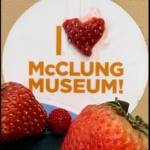
As spring wanes and summer warms up, plants are blooming and producing fruits to distribute seeds. Our June Plant of the Month focuses on two strawberry species native to the East Tennessee region. This edible summer perennial is known as the Wild and/or the Alpine Strawberry. Both are currently in bloom and producing fruits for a tasty summer treat right off the stem!
The Fragaria genus includes multiple strawberry plant species, but only two are native to North America: Wild Strawberry (Fragaria virginiana) and the Alpine/ Woodland Strawberry (Fragaria vesca). These two species are commonly identified as the same plant, but through closer examination of this plant’s form, we can see the differences between them.
The Wild Strawberry’s yellow seeds (achenes) are in pits or holes on the surface of the fruit, while the Alpine/ Woodland Strawberry’s seeds are on the surface of the fruit. Both species propagate through roots or runners, also known as stolons, allowing the plant to expand horizontally and sprawl over the ground surface to produce more plants. Strawberry plants also propagate through seed as well as cloning through rhizomatous or mat-like root growth forms.
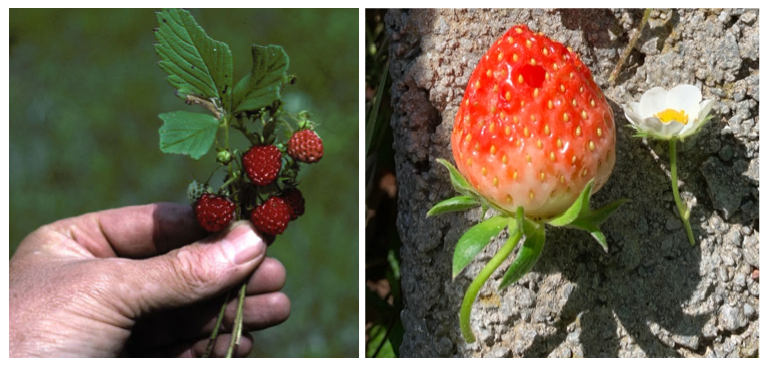
F. virginiana (image courtesy UTK Herbarium) and F. vesca (image courtesy Peggy Humes)
Family Characteristics
The Strawberry plant is part of the Rose Family (Rosaceae), the third most economically important food crop family in the United States. Characteristics for recognizing plants in the Rose Family in your own backyard include:
- cup-like flower (hypanthium) with fused petals and multiple stamens (which produce the pollen)
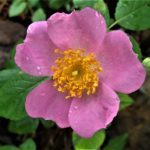
Example of hypanthium: climbing rose (image by Sid Vogelpohl, Arkansas Native Plant Society)
- leaves with serrated (toothlike) edges, sometimes in the form of three separate leaflets
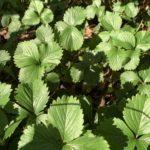
Example of serrated leaves: Alpine Strawberry (image courtesy Peggy Humes)
- fruits/seeds are either a pome(apple), drupe (cherry), capsule, or achene (strawberry).
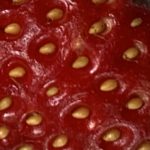
Example of achenes: Alpine Strawberry (image courtesy Peggy Humes)
Strawberry Characteristics
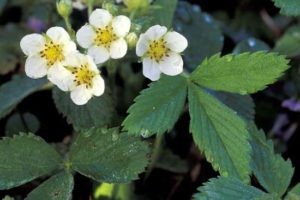
Wild Strawberry flowers (image by Thomas Barnes)
These perennial fruit species require low, shaded growth with indirect light, growing 3 to 7 inches in height and only produce fruit once in the season. Their flowers include 5 white petals on stalks separate from the leaves. The red fruits typically contain over 100 achenes (seeds) embedded on the surface or in holes on the fruit.
Fun Facts
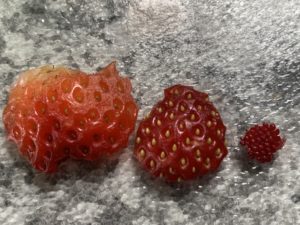
Strawberry achenes, from left to right: Cultivated, Alpine, and Mock Strawberries (image courtesy Peggy Humes)
The majority of the strawberries we purchase from the store are considered cultivated garden strawberries. Modern cultivated strawberries have been specially cultivated for their larger strawberry fruits. This cultivated strawberry, Fragaria x ananassa, was historically developed through the cross pollination of two wild species in the New World: F. virginiana, native to eastern North America, and F. chiloensis, the South American Beach Strawberry, native to Chile.
Did you know that the fleshy part of a strawberry is neither a berry or fruit in terms of botanical classification? The red, fleshy part of a strawberry’s overall form is not the fruit of the plant, but rather a vehicle for the exterior fruits, which are the yellow seeds (achenes) on the surface of the strawberry. The achene fruits provide a protective sheath encasing the tiny interior seed.
Did you know that Wild and Alpine Strawberries are often mistaken for Mock Strawberries (Potentilla indica)? The Mock Strawberry also has tooth-like leaves in three separate leaflets but are smaller in size. Mock Strawberry plants have yellow rather than white flowers and produce small red berries with a dry, crunchy texture and bitter taste. Mock Strawberries are not typically consumed by humans, whereas numerous cultural groups – both today and in the past – have used Wild and Alpine Strawberries as a tasty food resource.

Alpine Strawberry (F. vesca) and Mock Strawberry (Potentilla indica) (images courtesy Peggy Humes)
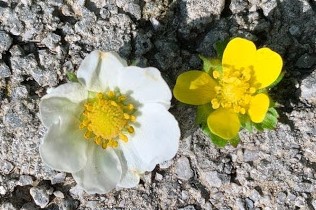
Flowers of Woodland (left) and Mock (right) Strawberries (images courtesy Peggy Humes)
Cultural Uses for this Plant:
Strawberries are generally best when eaten raw off the vine, as the fruit does not freeze or refrigerate well. But they provide more than just a food source, as the entire plant was used medicinally by native groups. Historically, Cherokee groups used wild strawberry medicinally for teas and poultices, primarily using the leaves and roots of the plant. This wild fruit aided a variety of ailments including disease of the kidneys and bladder, jaundice, scurvy, dysentery, to remove tartar from the teeth, and also as a nerve tonic. Strawberry plants were also historically consumed and utilized by European, African, and African American individuals. The fruit was used in desserts, preserves, and also a quick snack for enslaved agricultural workers in the fields.
The Cherokees tell a legend about the creation of the strawberry. First Woman and First Man began to quarrel, and First Woman finally got so angry that she walked off to the east, saying she would never come back. After a while, First Man became lonely and started after her but couldn’t catch up. The Sun felt sorry for him and placed ripe huckleberries in First Woman’s path to slow her down, but she kept walking. The Sun placed ripe blackberries, and then blueberries and serviceberries, and many other fruits in her path, but she kept walking. Finally, the Sun placed a new fruit in her path that she had never seen before, with a fragrance she had never before smelled, and bright red berries. She stopped to pick one, and it was the sweetest fruit she had ever tasted. As she ate the fruit, her anger faded, and she missed First Man. She picked as many berries as she could carry, and headed back west on the path. When she met First Man, they shared the berries and then walked home. Today, Cherokees often keep strawberries at their homes and see them as symbols of good luck. The Cherokee word for strawberry is “a-ni”.
Sources and Resources:
Bebeau, G.D. 2014. Virginia Strawberry. Friends of the Wild Flower Garden, Inc. Electronic document.
Eastman, John. 2014. Wildflowers of the Eastern United States. Stackpole Books, Mechanicsburg, Pennsylvania.
Elpel, Thomas J. 2018. Botany in a Day: The Patterns Method of Plant Identification 6th ed. HOPS Press, Pony, Montana.
Fernald, Merritt, and Alfred Kinsey. 1943. Edible Wild Plants of Eastern North America. Harper & Row, New York City, New York.
Hamel, Paul, and Mary Chiltoskey. 2002. Cherokee Plants and their uses: a 400-year history. Cherokee Publications. Cary, North Carolina.
Hilty, John. 2021.Wild Strawberry. Illinois Wildflowers. Electronic document.
Horn, Dennis, Tavia Cathcart, Thomas Hemmerly, and David Duhl. 2018. Wildflowers of Tennessee, the Ohio Valley, and the Southern Appalachians. Lone Pine Publishing, Tukwila, Washington.
Mills, David. 2017. Strawberry. Wild Foods Home Gardens. Electronic document.
2019. Plants for the Future. Missouri Botanical Gardens. Electronic document.
Moerman, Daniel. 2004. Native American Ethnobotany Database. Electronic document.
Judson, Katharine Berry. 1913 (2021). Origin of Strawberries. Legends of America. Electronic document.
Vogelpohl, Sid. 2019. Know Your Natives. Arkansas Native Plant Society. Electronic document.